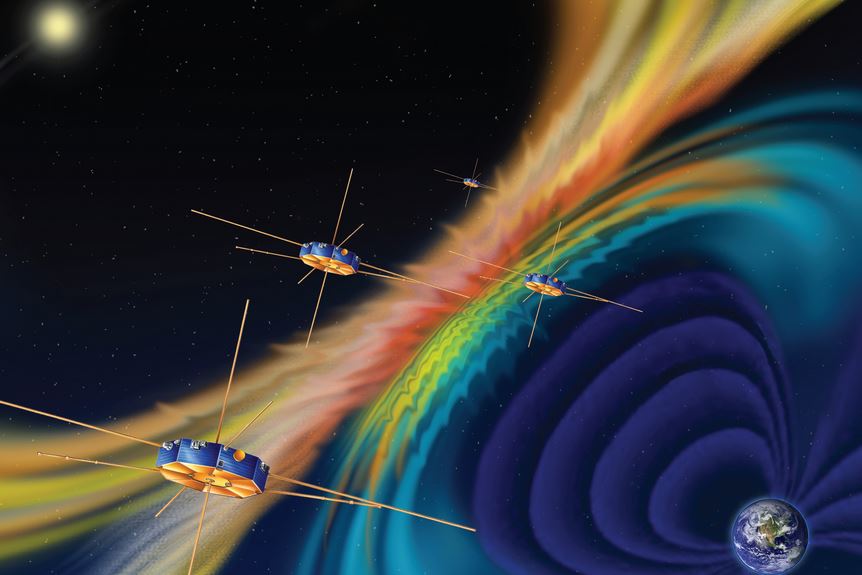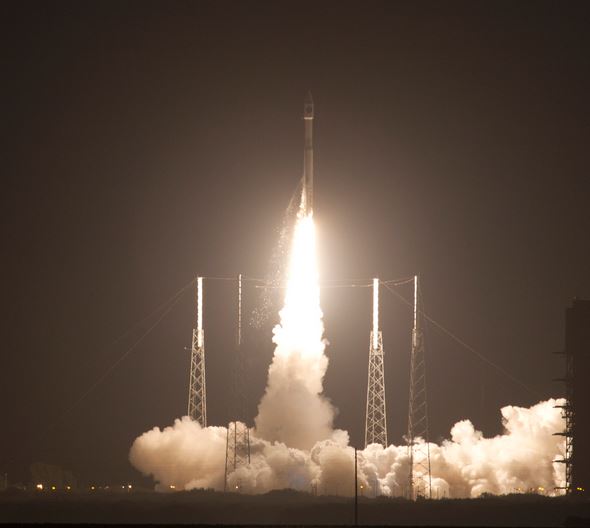At 10:44 EDT on Thursday, NASA launched four Magnetospheric Multiscale spacecraft to study a phenomenon called magnetic reconnection – a process thought to trigger some of our solar system’s most powerful explosions.
The spacecraft (satellites) where mounted one on top of the other on a United Launch Alliance Atlas V 421 rocket, which lifted off successfully from Cape Canaveral Air Force Station, Florida.
When it reached orbit, each satellite was deployed in a sequence of five-minute intervals, starting at 12:16am EDT on Friday, the last separation took place at 12:31 am. Nine minutes later NASA engineers and scientists confirmed the health of all separated spacecraft.

Artist’s impression of the MMS observatory fleet with rainbow magnetic lines. (Image Credit: NASA)
Project Manager at NASA’s Goddard Space Flight Center in Greenbelt, Maryland, Craig Tooley, said:
“I am speaking for the entire MMS team when I say we’re thrilled to see all four of our spacecraft have deployed and data indicates we have a healthy fleet.”
Scientific observations start in September
Over the coming weeks, the NASA team will deploy antennas and booms on the satellites, and test all instruments. The observatories will later be placed in a pyramid formation, which is ideal for science observations, which are scheduled to begin in early September.
Principal Investigator for the MMS (Magnetospheric Multiscale) instrument suite science team at the Southwest Research Institute in San Antonio (SwRI), Jim Burch, said:
“After a decade of planning and engineering, the science team is ready to go to work. “We’ve never had this type of opportunity to study this fundamental process in such detail.”
The satellites will provide the first 3-dimensional views of magnetic reconnection occurring in Earth’s magnetosphere – the region around our planet in which the motion of charged particles is dominated by its magnet field, i.e. Earth’s protective magnetic space environment.

The United Launch Alliance Atlas V rocket with NASA’s MMS spacecraft on board launches from the Cape Canaveral Air Force Station Space Launch Complex 41. (Image Credit: NASA)
Studying magnetic reconnections
Magnetic reconnection refers to the breaking and reconnecting of oppositely directed magnetic field lines in a plasma. The magnetic fields connect, disconnect and reconfigure explosively, releasing massive bursts of energy, as powerful as an explosion of billions of megatons of trinitrotoluene (TNT).
These explosions can blast particles hurtling through space at near light speed.
NASA hopes the mission, apart from giving us a better understanding of magnetic reconnection, may also provide insight into these super-powerful events, which can mess with modern technological systems such as electrical power grids, GPS navigation and communications networks.
NASA wrote:
“By studying reconnection in this local, natural laboratory, scientists can understand the process elsewhere, such as in the atmosphere of the sun and other stars, in the vicinity of black holes and neutron stars, and at the boundary between our solar system’s heliosphere and interstellar space.”
The satellites will fly in tight formation through regions of reconnection activity. They carry sensors that can measure the space environments one hundred times faster than in any previous mission.
Interim Director for NASA’s Heliophysics Division at the agency’s Headquarters in Washington, Jeff Newmark, said:
“MMS is a crucial next step in advancing the science of magnetic reconnection – and no mission has ever observed this fundamental process with such detail. The depth and detail of our knowledge is going to grow by leaps and bounds, in ways that no one can yet predict.”
This is the fourth mission in NASA’s Solar Terrestrial Probes Program.
Goddard, which built, integrated and tested the four MMS spacecraft, is in charge of the overall mission management and operations. The lead investigator for the MMS instruments science team is based at SwRI. The MMS Science Operations Center at the Laboratory for Atmospheric and Space Physics, University of Colorado, is in charge of operations planning and instrument commanding.
NASA Video – MMS Mission Overview
Tom Moore, Senior Project Scientist, outlines the three instrument suites on board the four MMS spacecraft.
